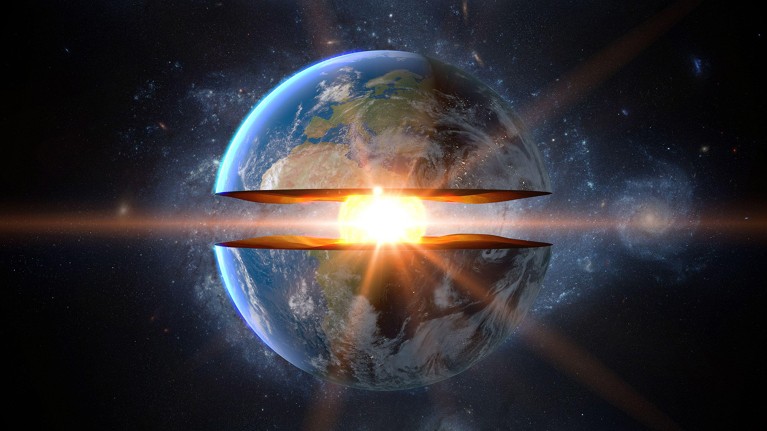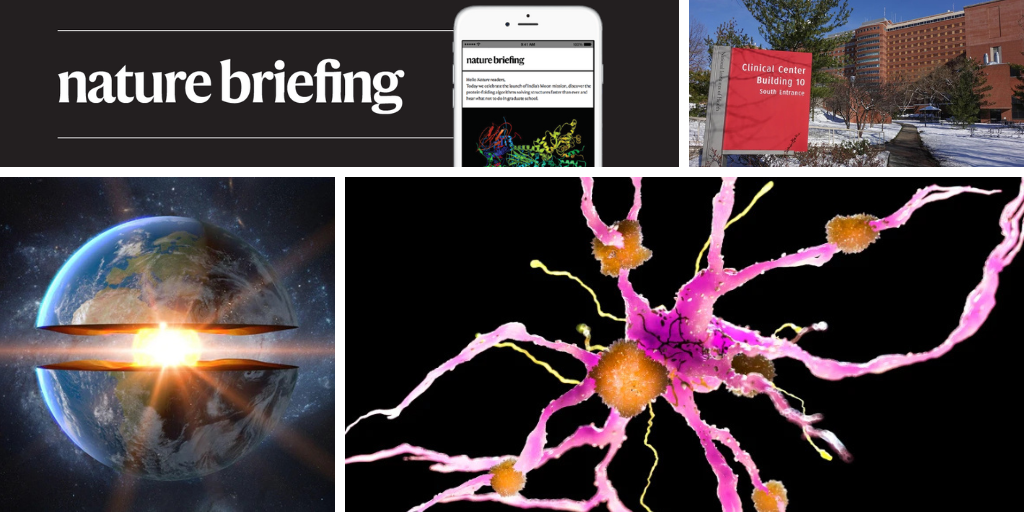Hello Nature readers, would you like to get this Briefing in your inbox free every day? Sign up here.

Earth’s inner core was long considered to be completely solid, but research has shown that it can be deformed.Credit: Pavel Chagochkin/Alamy
By analysing how seismic waves from earthquakes travelled through the planet, scientists have found that Earth’s inner core is changing shape. They noted that the waveforms of some seismic signals changed between 2004 and 2008, and attributed the phenomenon to the inner core — normally thought to be solid and unyielding – bulging in some areas. Changes in the dynamics of the core could affect the Earth’s magnetic field and the length of our 24-hour day. “After decades of research and debates, we are coming to an ever-clearer picture of the changing inner core,” says seismologist Xiaodong Song.
Reference: Nature Geoscience paper
A US judge has blocked a 15% cap on ‘research overhead’ that would have slashed billions of dollars of funding for universities and hospitals as part of President Donald Trump’s controversial crackdown of government spending. The policy, announced by the US National Institutes of Health on Friday, would affect research institutions’ ability to pay for electricity, computing resources, administrative personnel and other necessities that keep research projects up and running. The pause is in response to lawsuits filed by US states, universities and organizations that represent universities, which contend that the policy was illegal and would cause “cutting-edge work to cure and treat human disease” to “grind to a halt”. Some research institutions had already frozen projects as a precaution.
A man with a mutation in a gene called PSEN2, which causes the brain to produce versions of the amyloid protein that are prone to forming the hallmark sticky plaques of Alzheimer’s disease, has reached his mid-70s with no cognitive decline. All of the man’s family members with the mutation had developed dementia around age 50. Scans revealed that the man’s brain was full of amyloid plaques. But it had very little abnormal tau — another protein that forms tangled threads inside neurons. Researchers found that the man has nine genetic variants that weren’t present in his relatives who had the PSEN2 mutation and that might have protected him from the disease.
Reference: Nature Medicine paper
When given the opportunity, Goffin’s cockatoos (Cacatua goffiniana) dip bland food in a ‘condiment’ to make it tastier. In a trial, cockatoos were offered bowls of cooked pasta and cauliflower or potatoes and carrots with a spread of dips: fresh water, plain soy yoghurt and blueberry soy yoghurt. The birds didn’t bother dipping carrots or cauliflower, but some would dunk pasta and potato in the blueberry yoghurt, often fully coating it, before eating. Their preference for the blueberry yoghurt suggests the decision was based on improving flavour rather than texture, a behaviour that has only been observed in macaques (and people).
Reference: Current Biology paper
Features & opinion
Toxicologist Matthew Campen estimates that he can isolate about 10 grams of microplastics from a donated human brain; that’s about the weight of an unused crayon. Scientists are scrambling to understand how these tiny fragments, which have been found in every recess of our planet and our bodies, affect our health. They need clear data to communicate potential risks to policymakers, and with plastic production reaching new highs every year, they’re in a race against time. “It’s very scary to think the concentration of plastics in my brain will go up several percentage points before we have answers,” says Campen.
In Outraged, social psychologist Kurt Gray explores why moral issues spark conflict and division. Gray reframes outrage as a defensive stance, often driven by fear that an action will harm a vulnerable individual. In political conflicts, “we disagree about which entities most need our protection”, he writes. He suggests that it is not evidence that will make us more sympathetic, but sharing our perspectives of who is being harmed. “Therein lies the book’s most outrageous tension: that it is not science that wins the day, but persuasive narratives and stories,” says political neuroscientist Leor Zmigrod in her review. “Let us hope that’s not entirely true.”
Astrophysicist Kelly Korreck loved working on NASA’s Parker Solar Probe. But the COVID-19 pandemic took away her favourite parts of the job: face-to-face mentoring, public engagement and conference travel. “It really took a toll,” says Korreck. “There was none of the joy that I experienced previously.” Korreck decided to take two months off to reset. This involved going on long walks, taking up painting and delegating tasks she couldn’t do. When she returned to work, she asked her mentors for ideas about how to do things differently so she could avoid going down the same path again. “There is life after burnout,” she says.
Happy International Day of Women and Girls in Science! The Nature Awards Inspiring Women in Science are now open. The awards celebrate and support the achievements of women in science; of all those who work to encourage girls and young women to engage with science, technology, engineering and mathematics; and of those who work to support women to stay in those careers around the world. Find out more, apply or recommend a friend or colleague here.
We’re also celebrating the winners of the Sony Women in Technology Award with Nature. Two mid-career scientists and one early-career scientist each win a prize of US$250,000 to support and accelerate their technological research, which encompasses fingertip sensors for viral detection, and the fusion of biology with electronics to enhance precision medicine.
Thanks for reading,
Flora Graham, senior editor, Nature Briefing
With contributions by Jacob Smith and Gemma Conroy
Want more? Sign up to our other free Nature Briefing newsletters:
• Nature Briefing: Careers — insights, advice and award-winning journalism to help you optimize your working life
• Nature Briefing: Microbiology — the most abundant living entities on our planet — microorganisms — and the role they play in health, the environment and food systems
• Nature Briefing: Anthropocene — climate change, biodiversity, sustainability and geoengineering
• Nature Briefing: AI & Robotics — 100% written by humans, of course
• Nature Briefing: Cancer — a weekly newsletter written with cancer researchers in mind
• Nature Briefing: Translational Research — covers biotechnology, drug discovery and pharma


